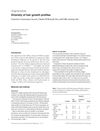TLDR Hair cortisol analysis shows sweat affects cortisol levels, and severe OSA may increase stress, but CPAP treatment doesn't significantly reduce physiological stress.
This thesis explored the methodological and clinical aspects of hair cortisol analysis, focusing on the role of sweat in contributing to hair cortisol concentrations and its application in assessing stress in obstructive sleep apnea (OSA) patients. It was found that sweat likely contributes to hair cortisol content, and conventional washing procedures may not reduce cortisol levels in hair from individuals with prolonged sweating. Clinically, hair cortisol analysis was used to investigate whether OSA is associated with increased stress, as OSA is linked to serious cardiovascular and metabolic issues potentially mediated by cortisol. The study concluded that cortisol secretion might be up-regulated in severe OSA cases, and while continuous positive airway pressure (CPAP) treatment may reduce psychological stress, it may not change physiological stress after 3 months.
 105 citations
,
February 2011 in “The Journal of Clinical Endocrinology & Metabolism”
105 citations
,
February 2011 in “The Journal of Clinical Endocrinology & Metabolism” Treating sleep apnea in young obese women with PCOS can improve heart health and insulin sensitivity.
122 citations
,
October 2010 in “Clinica Chimica Acta” 119 citations
,
August 2010 in “Journal of Investigative Dermatology” 217 citations
,
July 2009 in “Experimental and Clinical Endocrinology & Diabetes” Hair analysis can track past cortisol levels in Cushing's Syndrome patients.
 501 citations
,
October 2008 in “Psychoneuroendocrinology”
501 citations
,
October 2008 in “Psychoneuroendocrinology” Hair cortisol levels can show increased stress during late pregnancy but only for up to six months.
567 citations
,
October 2007 in “Clinical and investigative medicine” Hair cortisol can be used to measure long-term stress exposure.
 115 citations
,
September 2005 in “International Journal of Dermatology”
115 citations
,
September 2005 in “International Journal of Dermatology” Different ethnic groups have unique hair growth patterns, with African hair growing slower and less dense, Asian hair growing fast but sparse, and Caucasian hair being densest; men are more likely to experience hair loss than women.
489 citations
,
June 2005 in “The FASEB Journal” Human hair follicles can produce cortisol like the body's stress response system.
89 citations
,
December 1998 in “The Journal of Steroid Biochemistry and Molecular Biology” Human hair can be used to measure reproductive hormones.
Hair cortisol content can indicate cortisol exposure and varies with age, puberty, and BMI in youth.
237 citations
,
September 2018 in “Clinical Biochemistry”


